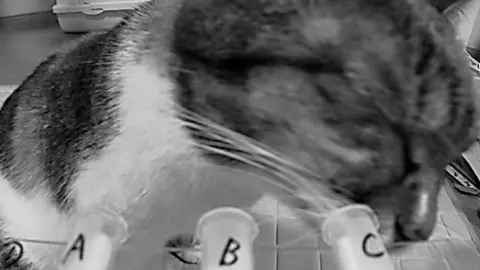Climate and science reporter
 Getty Images
Getty ImagesDomestic cats can tell the difference between the smell of their owner and that of a stranger, a new study suggests.
The study by Tokyo University of Agriculture found cats spent significantly longer sniffing tubes containing the odours of unknown people compared to tubes containing their owner’s smell.
This suggests cats can discriminate between familiar and unfamiliar humans based on their odour, the researchers say, but that it is unclear whether they can identify specific people.
Cats are known to use their strong sense of smell to identify and communicate with other cats, but researchers had not yet studied whether they can also use it to distinguish between people.
Previous studies of human recognition by cats have shown they are able to distinguish between voices, interpret someone’s gaze to find food, and change their behaviour according to a person’s emotional state that is recognised via their odour.
In the study published on Wednesday, researchers presented 30 cats with plastic tubes containing either a swab containing the odour of their owner, a swab containing the odour of a person of the same sex as their owner who they had never met, or a clean swab.
The swabs containing odours had been rubbed under the armpit, behind the ear, and between the toes of the owner or stranger.
Cats spent significantly more time sniffing the odours of unknown people compared to those of their owner or the empty tube, suggesting they can discriminate between the smells of familiar and unfamiliar people, the researchers said.
The idea of sniffing an unknown stimulus for longer has been shown before in cats – weaned kittens sniff unknown female cats for longer compared to their mothers.
However, the researchers cautioned that it cannot be concluded the cats can identify specific people such as their owner.
“The odour stimuli used in this study were only those of known and unknown persons,” said one of the study’s authors, Hidehiko Uchiyama.
“Behavioural experiments in which cats are presented with multiple known-person odour stimuli would be needed, and we would need to find specific behavioural patterns in cats that appear only in response to the owner’s odour.”
 Miyairi et al., 2025, PLOS One, CC-BY 4.0
Miyairi et al., 2025, PLOS One, CC-BY 4.0Serenella d’Ingeo, a researcher at the University of Bari who was not involved in this study but who has studied cat responses to human odours, also said the results demonstrated cats react differently to familiar and unfamiliar smells, but that conclusions couldn’t be drawn over their motivations.
“We don’t know how the animal felt during the sniffing… We don’t know for instance whether the animal was relaxed or tense,” she said.
Ms d’Ingeo added that the presentation of samples to cats by their own owners, who naturally added their own odour to the environment, could have increased the cats’ interest in the unfamiliar ones.
“In that situation, owners present not only their visual presence but also their odour,” she said.
“So of course if they present other odours that are different from their personal one, in a way they engage more the cat.”
The study’s authors concluded that “cats use their olfaction [smell] for the recognition of humans”.
They also noted cats rubbed their faces against the tubes after sniffing – which cats do to mark their scent on something – indicating that sniffing may be an exploratory behaviour that precedes odour marking.
The researchers cautioned that this relationship needs further investigation, along with the theory of whether cats can recognise a specific person from their smell.









